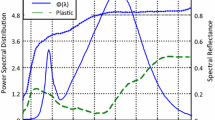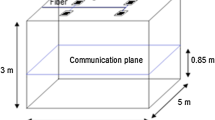Abstract
The present paper investigates the impact of three radiation patterns of LED namely Lambertian, Batwing, Elliptical on the BER performance of 4 × 4 indoor multiple-input multiple-output (MIMO) visible light communication (VLC) system. The BER simulation has been done using LOS and LOS plus first reflection (L-R1) signals for ceiling-mounted and wall-mounted LEDs. For the case of ceiling-mounted LEDs, impulse response and BER have been computed using those radiation patterns at the centre and corner of a room (5 m × 5 m × 3 m). It has been found that LED having Elliptical radiation profile is more suitable for LOS signal when receiver is placed at the centre position whereas, Batwing radiation is suitable for L-R1 signal, both at the centre and corner positions. In the case of wall-mounted LEDs, impulse response and BER have been determined at the centre of the room using LOS and L-R1 signals. The results show that Batwing has least BER using LOS signal due to its wide radiation beam, but for L-R1 signal, the Elliptical profile having its narrow radiation beam has provided better BER performance. The present study shows that the BER in MIMO-VLC system not only depends on the transmitter and receiver position but also on the radiation patterns of LED and higher order reflection signals.














Similar content being viewed by others
References
Qiao, L., et al. (2018). Performance analysis of space multiplexing by superposed signal in multi-dimensional VLC system. Optics Express,26(16), 19762–19772.
Wang, Z., Han, S., & Chi, N. (2020). Performance enhancement based on machine learning scheme for space multiplexing 2×2 MIMO VLC system employing joint IQ independent component analysis. Optics Communications,458, 124733.
Sathar, et al. (2019). Filter-bank modulation based signal design and transmission techniques for intensity modulated MIMO visible light communication systems. Wireless Personal Communications. https://doi.org/10.1007/s11277-019-06905-x.
Sekhar, K. R., & Mitra, R. (2019). MBER combining for MIMO VLC with user mobility and imperfect CSI. IEEE Communications Letters,24(2), 376–380.
Jain, S., Mitra, R., & Bhatia, V. (2018). Adaptive precoding-based detection algorithm for massive MIMO visible light communication. IEEE Communications Letters,22(9), 1842–1845.
Nuwanpriya, S., Ho, C. S., & Chen., (2015). Indoor MIMO visible light communications: Novel angle diversity receivers for mobile users. IEEE Journal on Selected Areas in Communications,33(9), 1780–1792.
Fath, T., & Haas, H. (2013). Performance comparison of MIMO techniques for optical wireless communications in indoor environments. IEEE Transactions on Communications,61(2), 733–742.
Wang, T. Q., & Green, R. J. (2015). MIMO optical wireless communications using ACO-OFDM and a prism-array receiver. IEEE Journal on selected areas in communications,33(9), 1959–1971.
Deng, P., Kavehrad, M. (2017). Software defined adaptive MIMO visible light communications after an obstruction. In Optical Fiber Communication Conference, Los Angeles OSA Th1E.5.
Hong, Y., Lian-Kuan, C., Zhao, J. (2017). Experimental demonstration of performance-enhanced MIMO-OFDM visible light communications. In Optical Fiber Communication Conference, Los Angeles, OSA Th1E.2.
Hong, Y., et al. (2016). On the performance of adaptive MIMO-OFDM indoor visible light communications. IEEE Photonics Technology Letters,28(8), 907–910.
Wang, T. Q., He, C., & Armstrong, J. (2017). Performance analysis of aperture-based receivers for MIMO IM/DD visible light communications. Journal of Lightwave Technology,35(9), 1513–1523.
Zhan, Z. et al. (2015). 1.2 Gbps non-imaging MIMO-OFDM scheme based VLC over indoor lighting LED arrangements. In 2015 Opto-Electronics and Communications Conference (OECC), Shanghai, IEEE, pp. 1–3.
Kumar, S. K. G. (2018). Effect of multipath reflection on BER performance of indoor MIMO-VLC system. Optical and Quantum Electronics,50(11), 388–406.
Rachev, et al. (2019). Improvement of the approximation accuracy of LED radiation patterns. Electronics,8(3), 337.
Hong, Y., Wu, T., & Chen, L. (2013). Improvement of transmission bandwidth for indoor optical wireless communication systems using an elliptical lambertian beam. IEEE Photonics Technology Letters,25(2), 907–910.
Moreno, I., et al. (2014). Modeling LED street lighting. Applied Optics,53(20), 4420–4430.
Ding, J., Chih-Lin, I., & Xu, Z. (2016). Indoor optical wireless channel characteristics with distinct source radiation patterns. IEEE Photonics Journal,8(1), 1–15.
Wang, Y., et al. (2017). Impact of LED transmitters’ radiation pattern on received power distribution in a generalized indoor VLC system. Optics Express,25(19), 22805–22819.
Kitamura, K., et al. (2010). Optical wireless digital-sound transmission system with 1-BitΔ∑-modulated visible light and spherical si solar Cells. IEEE Sensors Journal,10(11), 1753–1758.
Acknowledgements
This research work is financially supported by the University Grant Commission (Ministry of Human Resource Development), Grant/Award number: F.15-9(JUNE)/2015(NET).
Author information
Authors and Affiliations
Corresponding author
Additional information
Publisher's Note
Springer Nature remains neutral with regard to jurisdictional claims in published maps and institutional affiliations.
Rights and permissions
About this article
Cite this article
Kumar, A., Ghorai, S.K. Effect of LED Radiation Pattern on BER Performance in Indoor Multipath MIMO-VLC System. Wireless Pers Commun 113, 2009–2026 (2020). https://doi.org/10.1007/s11277-020-07305-2
Published:
Issue Date:
DOI: https://doi.org/10.1007/s11277-020-07305-2




